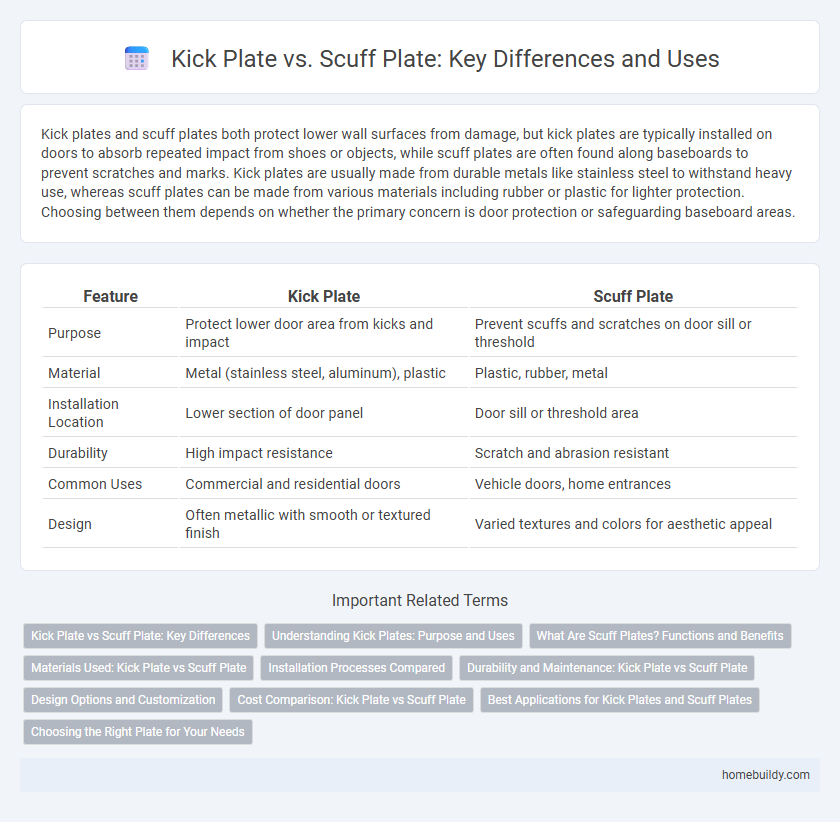Kick plates and scuff plates both protect lower wall surfaces from damage, but kick plates are typically installed on doors to absorb repeated impact from shoes or objects, while scuff plates are often found along baseboards to prevent scratches and marks. Kick plates are usually made from durable metals like stainless steel to withstand heavy use, whereas scuff plates can be made from various materials including rubber or plastic for lighter protection. Choosing between them depends on whether the primary concern is door protection or safeguarding baseboard areas.
Table of Comparison
| Feature | Kick Plate | Scuff Plate |
|---|---|---|
| Purpose | Protect lower door area from kicks and impact | Prevent scuffs and scratches on door sill or threshold |
| Material | Metal (stainless steel, aluminum), plastic | Plastic, rubber, metal |
| Installation Location | Lower section of door panel | Door sill or threshold area |
| Durability | High impact resistance | Scratch and abrasion resistant |
| Common Uses | Commercial and residential doors | Vehicle doors, home entrances |
| Design | Often metallic with smooth or textured finish | Varied textures and colors for aesthetic appeal |
Kick Plate vs Scuff Plate: Key Differences
Kick plates protect doors from damage caused by feet, providing a durable barrier typically made from metal or plastic and installed at the door's bottom section. Scuff plates serve a similar protective purpose but are often more focused on preventing surface wear and scratches on floors or thresholds, usually constructed from materials suited for high-traffic areas. The key differences lie in their placement and primary function: kick plates guard doors against impacts, while scuff plates prevent abrasion and scuff marks on adjacent surfaces.
Understanding Kick Plates: Purpose and Uses
Kick plates protect doors from damage caused by foot traffic, primarily installed at the bottom section to prevent scuffs and dents. Unlike scuff plates, which are often used on floors or lower wall areas to guard against abrasion, kick plates specifically enhance door durability and aesthetics. Commonly made from durable materials such as stainless steel, aluminum, or vinyl, kick plates are essential in high-traffic environments like commercial buildings and public facilities.
What Are Scuff Plates? Functions and Benefits
Scuff plates, also known as door sill protectors, shield vehicle door sills from scratches, dirt, and wear caused by foot traffic during entry and exit. They enhance the car's appearance by preventing scuffs and dents, thus maintaining resale value and interior cleanliness. Made from durable materials like stainless steel, aluminum, or plastic, scuff plates also often feature decorative designs or illuminated logos for added customization.
Materials Used: Kick Plate vs Scuff Plate
Kick plates are commonly made from durable metals such as stainless steel, aluminum, or brass, providing robust protection against frequent impacts on doors. Scuff plates often use similar materials but can include high-density plastics or rubber composites to resist surface abrasions and wear. The choice of materials in both kick plates and scuff plates directly impacts their effectiveness in safeguarding door surfaces from damage caused by foot traffic and equipment.
Installation Processes Compared
Kick plates are typically easier to install than scuff plates, as they usually require simple surface mounting with adhesive or screws directly onto doors or walls. Scuff plates often involve a more complex installation process, sometimes requiring precise alignment and attachment to flooring or lower wall sections using screws, nails, or specialized mounting brackets. The straightforward installation of kick plates makes them a preferred choice for quick door protection, while scuff plates are chosen for durability in high-traffic floor areas despite the more involved setup.
Durability and Maintenance: Kick Plate vs Scuff Plate
Kick plates and scuff plates both protect surfaces but differ significantly in durability and maintenance requirements. Kick plates, usually made from stainless steel or aluminum, offer superior resistance to impact and scratches, requiring minimal upkeep to maintain their appearance. Scuff plates, often constructed from plastic or softer metals, are more prone to wear and may need frequent cleaning or replacement to preserve surface integrity.
Design Options and Customization
Kick plates offer a wide range of design options, including various materials such as stainless steel, brass, and aluminum, which allow for enhanced durability and aesthetic appeal. Customization options include different sizes, finishes, and engraving possibilities, making kick plates adaptable to both residential and commercial environments. Scuff plates, while similar, typically have fewer customization choices and are primarily designed to protect lower door surfaces from wear rather than provide decorative enhancement.
Cost Comparison: Kick Plate vs Scuff Plate
Kick plates generally cost more than scuff plates due to their thicker material and enhanced durability designed to protect doors from heavy impact. Scuff plates, often made of lighter materials, provide basic protection against scratches and are more budget-friendly for light to moderate use. The price differential reflects the intended usage intensity, with kick plates suited for high-traffic areas justifying their higher investment.
Best Applications for Kick Plates and Scuff Plates
Kick plates offer superior protection against door damage in high-traffic areas, making them ideal for commercial buildings, schools, and hospitals where frequent contact occurs at lower door sections. Scuff plates, while also protective, are better suited for decorative purposes and light-duty applications such as residential doors or interior spaces that primarily require scratch resistance. Choosing between kick plates and scuff plates depends on the level of impact resistance needed and the specific environment's wear-and-tear demands.
Choosing the Right Plate for Your Needs
Kick plates offer durable protection for door bottoms against foot traffic and equipment, making them ideal for high-usage commercial settings. Scuff plates protect wider areas of the door surface from scratches and marks, often providing aesthetic appeal along with function. Selecting the right plate depends on the level of impact expected and the area that requires shielding, with kick plates suited for robust, localized defense and scuff plates for broader, surface-level protection.
Kick plate vs Scuff plate Infographic

 homebuildy.com
homebuildy.com